
News
Drone Safety
Heliguy looks at drone safety and risk assessments with drones. ... Read More
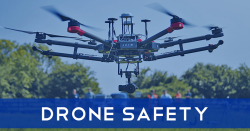
Drone Safety Operating a drone safely is the most important factor for all drone pilots. It doesn’t matter whether you’re a commercial drone operator or a hobbyist, keeping health and safety at the forefront of your mind is a definite must. You need to keep yourself and everyone safe when flying. We have recently looked into drone safety by investigating causes for drone crashes and flyaways and we’re continuing the theme of safety by looking at drone risk assessments.
In this post, we are looking at risk assessments with a focus on commercial drone operators however, the information will be useful to anyone who flies a drone, giving general tips on safety and what kind of things you should be looking out for. Keep reading for information on risk assessments and what you should be doing when operating a drone.
Drone Law
In the UK, the CAA is the regulator of all aviation including drones. They aim to ensure safety within all aviation. The Air Navigation Order (ANO) 2016, includes the following statement under article 241: “A person must not recklessly or negligently cause or permit an aircraft to endanger any person or property.” Therefore, ensuring safe flight is a legal responsibility for commercial and non-commercial drone operators. Using a risk assessment can help pilots guarantee the risks they may face during flight are reduced to a minimum.
What is a Risk Assessment?
Risk assessments are a tool designed to identify any potential hazards that may harm you or others when flying your drone. The assessment evaluates the potential hazards and the possible risk to safety, then outlines the actions you will take either remove or reduce the chance of harm. Risk assessments are a huge part of health and safety and you may be required by law to complete one. Keep reading to see whether you need to complete a risk assessment and for general tips on drone safety.
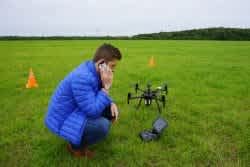
Do I Need to Complete a Risk Assessment?
Regulation 3 of the Management of Health and Safety at Work Regulations 1999 states a risk assessment is a legal responsibility of anyone who is either an employer or self-employed in the UK. Therefore, any commercial drone pilots in the UK are required to complete a risk assessment of their operations. If the company employs fewer than five employees, you don’t need to have a risk assessment written out, but must ensure you have considered all hazards and risks to keep yourself and any staff safe. For commercial drone operators, it is recommended you include a general risk assessment within your Operations Manual that you submit to the CAA. You should then complete a risk assessment for every individual operation and ensure all areas are covered. It’s worth noting though, any risk assessment detailed in your Operations Manual must be followed during each flight. This includes PPE (Personal Protective Equipment) and all specified procedures.
What do I Need to Include?
There are several areas you will need to include in your risk assessment and tools that can be used to assist you with this. Below we will cover everything you need to cover.
Identify Hazards
Firstly, you will need to identify all hazards that may occur. You must assess hazards in relation to yourself, anyone you’re working with and all members of the public. You should consider the processes you will be using, the equipment and any external factors that are likely including weather etc.
Identify Who is at Risk

Evaluate the Risk
Once you have identified the hazards and who is at risk, you need to evaluate the level of each of the risks and how you’re going to remove or reduce the risk when reasonably practicable. You should consider whether the risk can be removed completely and if not, what you can do to make the risk ALARP (as low as reasonably practicable). This is a term used in health and safety risk management and is done by analysing the time, trouble and cost that’s required to control the risk against the risk. The measures you put in place to reduce the risk should be justifiable and only include exactly what you need to remove or reduce the risk. Tools such as a risk matrix and hierarchy of control can be used to help you during the risk assessment process. Keep reading for the details of the tools and how they can help you.
Risk Matrices
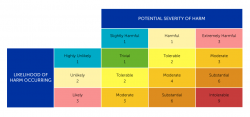
Hierarchy of Control

Hierarchy of Controls Let’s break down each section into more detail:
Elimination – Redesign your operation to remove the hazard completely.
Substitution – Replace whatever equipment or process is causing the hazard.
Engineering Controls – Use additional equipment to increase safety and reduce the risk of harm. For example, prop guards or geofencing could be used.
Administrative Controls – Implement different procedures for increased safety during operation.
PPE - Personal protective clothing and equipment. Due to the popularity of PPE with drone users, we have given it its own section below. The hierarchy of control is a great way of identifying and removing or reducing risk. It will help guide you through the decision-making process starting with the most effective options. Like a risk matrix, you are not obliged to use this tool. Keep reading for more information on PPE within the drone industry.
Personal Protective Equipment
PPE within the drone industry comes in the form of equipment such as high-visibility clothing, safety footwear and hard hats. The use of PPE has become very popular recently with UAV pilots as well as a lot of other industries however, it is not often necessary for a drone operator to use it. HSE (Health and Safety Executive) who regulate health and safety in the UK advise that PPE should only be used as a last resort and when completely necessary. For the majority of drone pilots, the use of equipment such as a high-visibility jacket isn’t actually required and in some cases, can be more hazardous. If wearing a jacket that will draw attention to you, a member of the public is more likely to approach you while flying, acting as a distraction from the flying drone. Heliguy recommends only using PPE when absolutely essential to the safe operation of your aircraft. Remember, as mentioned above, if you write in your Operations Manual you will use PPE, you will have to do this on every operation!
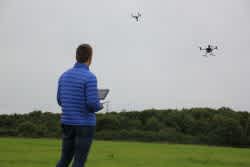
Risk Assessment Summary
The above should be detailed within a commercial drone operator’s Operations Manual for the expected risks you will encounter within every standard job. You should also complete a risk assessment on each new site you’re working on, especially if operating in circumstances you're unfamiliar with. For example, if permissions have been given to fly around people, you must assess the added risks before operating. A risk assessment should be completed with any changes in your business and kept up to date. Ad hoc changes should be written down if you have five or more employees and formal updates to be added to your Operations Manual as soon as possible to guarantee your manual is up to date.
Heliguy Risk Assessment Examples
When flying a drone, there are a number of hazards you might encounter and would need to consider as part of your risk assessment. Heliguy has detailed a few of the areas you could consider for your risk assessment. This list is not exhaustive and you will need to include a lot more in your risk assessment.
Example One
Job and Hazard- You have been hired to photograph a wedding which involves aerial work. In order to take the best photographs of the wedding, you will have to get close to the wedding party and some buildings. This is potentially putting members of the public at risk due to the proximity of the aircraft to the guests.
Options – Several engineering options are available to reduce the risk of harm to the guests at the wedding. The use of geo-fencing will allow you to control the areas you can fly and keep at an acceptable level from the guests. Obstacle avoidance sensors will help the aircraft automatically avoid flying near guests increasing safety and reducing the risk. Propeller guards can also increase safety with the public. Manually monitoring your aircraft’s separation distance from the public also provides an administrative control, again reducing the risk to a reasonably practicable level. The combination of these tactics will help reduce the risk to the lowest possible level.
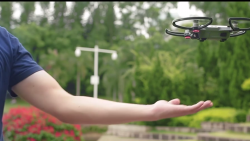
Example Two
Job and Hazard – You are filming with your aircraft on the beach with only sand to take off and land you on. You consider hand launching and catching your drone to stop damage with sand or the aircraft falling over. Option – Rather than hand launching the aircraft and putting yourself at risk, the option of using a landing pad completely eliminates the risk of injury and takes you out of harm’s way.
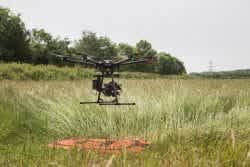
Example Three
Job and Hazard – You have been hired for aerial surveillance work on a building site where several properties are being built. Heavy machinery is being used on the site which is constantly moving and you have no set location to stand to operate the aircraft. Options – Discussing your plan with the site manage along with PPE in the form of a hard hat, high visibility jacket and steel toe capped boots is the best option for increased safety. High visibility clothing will help others on the site see you and protective clothing will help protect you from falling objects etc. Letting the site manager know your plan will allow them to warn workers and have vehicles avoid your location.
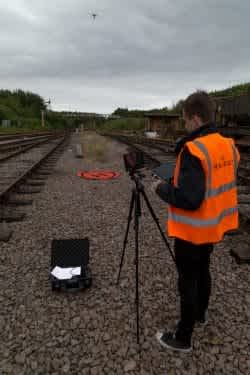
Heliguy using PPE
These three examples give you an idea of specific hazards and risks and how you can combat them.
These examples pick out precise areas of the job, however, there are a lot of other aspects that you would need to consider in your risk assessment.
Summary
Safety with your drone is imperative and a legal responsibility for all drone pilots in the UK. Completing a risk assessment before each flight will help you fly your aircraft as safely as possible. If you’re a commercial drone operator, include the details in your Operations Manual for the generic jobs you cover. Review the details before every flight to ensure you’ve covered every situation and reduced the risk to ALARP. As a hobbyist, it would still be beneficial to complete some form of risk assessment to increase the safety of your flights. Remember to always fly your drone safely and follow the above advice to remove or reduce the risk to you, employees and the public.
The Heliguy team are happy to help with your all your queries. Give us a call on 0191 338 6054 or email us at info@heliguy.com.
Keep checking back to Heliguy’s Insider Blog for more announcements, insights into drones and, of course, the latest news from the drone industry.
